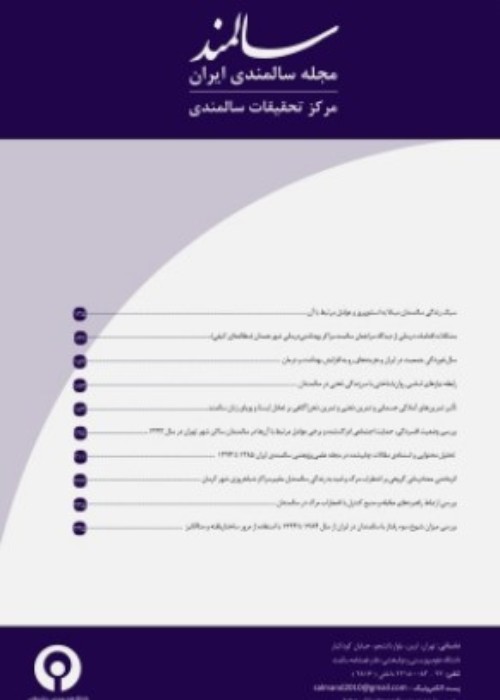Comparing the Musculoskeletal Profile of the Elderly with and without History of Falling
Author(s):
Abstract:
Objectives
The purpose of current study was to study and compare the musculoskeletal profile of the elderly with and without the history of falling living at nursing homes in Rasht, Iran.Methods & Materials: A total of 54 elderly men and women, aged 60 years and older participated in this study. Of them, 16 (fall group) experienced a fall in the previous year (Mean (SD) of age, 79 (9.90) years; height, 1.51 (0.103) m; and weight 60.03 (11.12) kg) and 38 (no fall group) had no history of falling (Mean (SD) of age, 70.16 (8.16) years; height 1.56 (0.11) m; and weight 65.6 (14.93) kg). The foot arch, distance between femoral condyles, kyphosis, lordosis, flexibility and the ability to walk were measured by ruler, caliper, flexible ruler, sit and reach test, and functional gait assessment questionnaires, respectively. Data analysis was done through independent t-test using SPSS. Study significance level was set at 0.05.
Results
In the fall group the mean (SD) of measured variables were as follows: body mass index (BMI), 25.95 (3.35) kg/m2; foot arch 9.94 (4.34) mm; flexibility, 8.25 (6.38) cm, lordosis 20.86 (9.48) degree; kyphosis 35.07 (14.98) degree. And in no fall group, the same variables were as follows: BMI, 26.87 (5.12) kg/m2; foot arch 10.95 (5.60) mm; flexibility 8.16 (5.24) cm; lordosis 26.66 (14.78) degree; and kyphosis, 41.11 (9.84) degree. These variables were not significantly different between the groups; however, the functional gait assessment and distance between femoral condyles test showed significant differences. In the group with a history of fall, the functional gait assessment and distance between femoral condyles were 12.50 (7.07) and 2.74 (2.38) cm and in the group without a history of fall functional gait assessment and distance between femoral condyles were 23.63 (5.49) and 1.20 (1.4) cm, respectively. According to the results, in the fall group, the distance between femoral condyles was more and the performance level was less (P≤0.05).Conclusion
Results showed that none of the variables of foot arch, flexibility, lordosis, and kyphosis were significantly different between 2 groups and were not risk factors for falling among older people. While the distance between femoral condyles and functional gait assessment in 2 groups were significantly different. It seems that functional gait assessment test and the distance between two condyles were the best indexes for the distinction between 2 groups. Perhaps, this method can be used as an appropriate way for predicting and consequently preventing the elderly from falling.Keywords:
Language:
Persian
Published:
Iranian Journal of Ageing, Volume:10 Issue: 38, 2016
Pages:
72 to 81
magiran.com/p1534227
دانلود و مطالعه متن این مقاله با یکی از روشهای زیر امکان پذیر است:
اشتراک شخصی
با عضویت و پرداخت آنلاین حق اشتراک یکساله به مبلغ 1,390,000ريال میتوانید 70 عنوان مطلب دانلود کنید!
اشتراک سازمانی
به کتابخانه دانشگاه یا محل کار خود پیشنهاد کنید تا اشتراک سازمانی این پایگاه را برای دسترسی نامحدود همه کاربران به متن مطالب تهیه نمایند!
توجه!
- حق عضویت دریافتی صرف حمایت از نشریات عضو و نگهداری، تکمیل و توسعه مگیران میشود.
- پرداخت حق اشتراک و دانلود مقالات اجازه بازنشر آن در سایر رسانههای چاپی و دیجیتال را به کاربر نمیدهد.
In order to view content subscription is required
Personal subscription
Subscribe magiran.com for 70 € euros via PayPal and download 70 articles during a year.
Organization subscription
Please contact us to subscribe your university or library for unlimited access!



